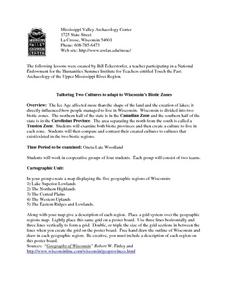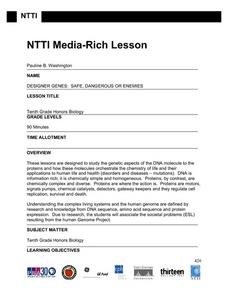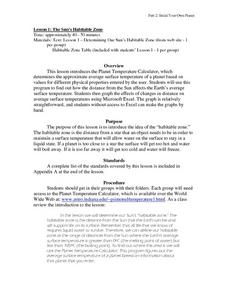Space Awareness
The Climate in Numbers and Graphs
Weather versus climate: weather relates to short time periods while climate averages the weather of a period of many years. Scholars learn about average temperature and precipitation in various climate zones and then apply statistics...
Smithsonian Institution
Cold War
The Cold War was not necessarily always cold in temperature, but the relationship between the United States and the Soviet Union sure was frigid! Scholars read various passages, view exhibition graphics, and observe an artifact from the...
Curated OER
Not Your Average Average
Students discover that if a distance is traveled in two or more segments at different average speeds, you cannot average the average speeds. Instead the total distance traveled must be divided by the total elapsed time. Students practice...
Curated OER
Intertidal Field Trip
Students explore an intertidal zone. In this science lesson, students travel to an intertidal zone. Students collect data and create species accumulation curves.
Curated OER
Activity #4 Ground Water Model In a Jar
Students devlop a model, which they illustrate a water table and allow for the discussion of common terms and illustrate what those terms mean. They comprehend that a flow rates, removal of contaminants, and the amount of water stored...
Curated OER
USH Industrialization: The effects of the railroads
Eleventh graders interpret a time zone map and describe the effects of the railroads. They discuss what a continent is, what you think it means if something is transcontinental and offer descriptions about some different inventions from...
Curated OER
Tailoring Two Cultures to Adapt to Wisconsin's Biotic Zones
Students examine the effect of the various ice ages on Wisconsin. In groups, they create a map representing the five geographic regions of Wisconsin. They must write out a description of each region to be placed on a poster board. ...
Curated OER
The Dead Zone: A Marine Horror Story
Students graph dissolved oxygen versus depth using data taken from NECOP Program. In this marine science lesson, students explain the causes of hypoxia. They recommend possible solutions to this problem.
Curated OER
Kid Zone Tree Math
What a fun way to practice addition! Your class must complete this number tree by adding two numbers at a time, in order to find the next numbers to add. The last number is provided for students to use as a checkpoint.
Curated OER
Kid Zone Tree Math 1
What a fun and different way to practice subtraction! Your class must complete this number tree by subtracting two numbers at a time, in order to find the next numbers to subtract. The last number is provided for students to use as a...
Wild BC
Carbon - The Short and the Long
For this complex game about the carbon cycle, the playing field is divided into air, living, and earth zones. Children are assigned to be either plants or animals, and collect carbon tokens as they proceed from zone to zone. While the...
Curated OER
La Belle Époque [1871-1914]:
Progress through various aspects of the "The Beautiful Era" in this presentation. Political, technological, and scientific contexts surround the time of innovation and change in the world landscape. The short length of this slide show...
Curated OER
Big Air Rules
Students discuss projectile motion using a basketball player taking off for a slam dunk, a fly ball launched off a hitter's bat, and a snowboarder flying off a pipe as examples. The lesson is expanded by introducing the mathematical...
Curated OER
Temperature and the Tomato
You will need a photovoltaic system and monitor at your school in order to obtain all of the data required to thoroughly implement this instructional activity. Your class monitors daily temperature and insolation amounts over a two week...
Curated OER
Interior Design Final Project
Students are introduced to the requirements for their final interior design project. In groups, they compare and contrast the characteristics of floor plans to the needs of families living in the houses. Individually, they design their...
Curated OER
More Practice Calculating Speed
In this speed worksheet, students calculate the average speed of an object or the distance an object travels. This worksheet has 13 word problems.
Curated OER
Tracking the Sun
Sixth graders plot the a day's movement of the sun across the sky using sun dials fashioned out of clear plastic bowls. They repeat the activity at various times throughout the year and record and compare their results.
Curated OER
Magnetic Storms
In this magnetic storms learning exercise, students use a graph of data collected over time showing the magnitude of a magnetic storm. Students use the data to solve 6 problems about the graph and they determine the strength of the storm...
Curated OER
Viewpoints
In this latitude and longitude worksheet, learners complete 10 matching questions identifying key features or locations on a map. Students also use lines of latitude and longitude to identify the time in 4 different places.
Curated OER
Hello Sun, Goodnight Moon
Students become familiar with different times around the world through the reading of 9 O'clock Lullaby. In this Earth, sun, moon lesson, students recognize the movement of the Earth and the relationship to the sun and the moon. ...
Curated OER
Entering the Twilight Zone
Students describe major features of cold seep communities and list organisms that are found in these communities. In this water habitat instructional activity students examine trophic levels, describe the process of chemosynthesis and...
Curated OER
The Sun's habitable Zone
High schoolers explore the average surface temperature of planets. They use the Planet Temperature Calculator to find the average temperature. Students explore how the distance from the sun affects the Earth's average surface...
National First Ladies' Library
Who’s on First? in the End Zone? at the net? in the Ring?
Pupils are introduced to some sport heroes from the 20th century. They are told that although many sports have their own Halls of Fame, there is no one list of the top 10 athletes from the 20th century. It is their job to research famous...
Curated OER
Interstellar Real Estate - Defining The Habitable Zone
Students explore the orbital characteristics a planetary home needs to support Earth-like life forms. They develop an understanding of critical planetary mass to determine which newly discovered planets might be capable of supporting life.
Other popular searches
- Time Zone Lesson
- Calculating Time Zones
- World Time Zones
- International Time Zones
- Lessons on Time Zones
- United States Time Zones
- Powerpoint and Time Zones
- Geography Time Zones
- Canadian Time Zones
- U.s. Time Zones
- Time Zone Lesson Maths
- Time Zones Lessons













![La Belle Époque [1871-1914]: PPT La Belle Époque [1871-1914]: PPT](http://content.lessonplanet.com/resources/thumbnails/292406/large/cgrmlwnvbnzlcnqymdeymtewoc0zmdqxni1ncdjpenquanbn.jpg?1414487063)











